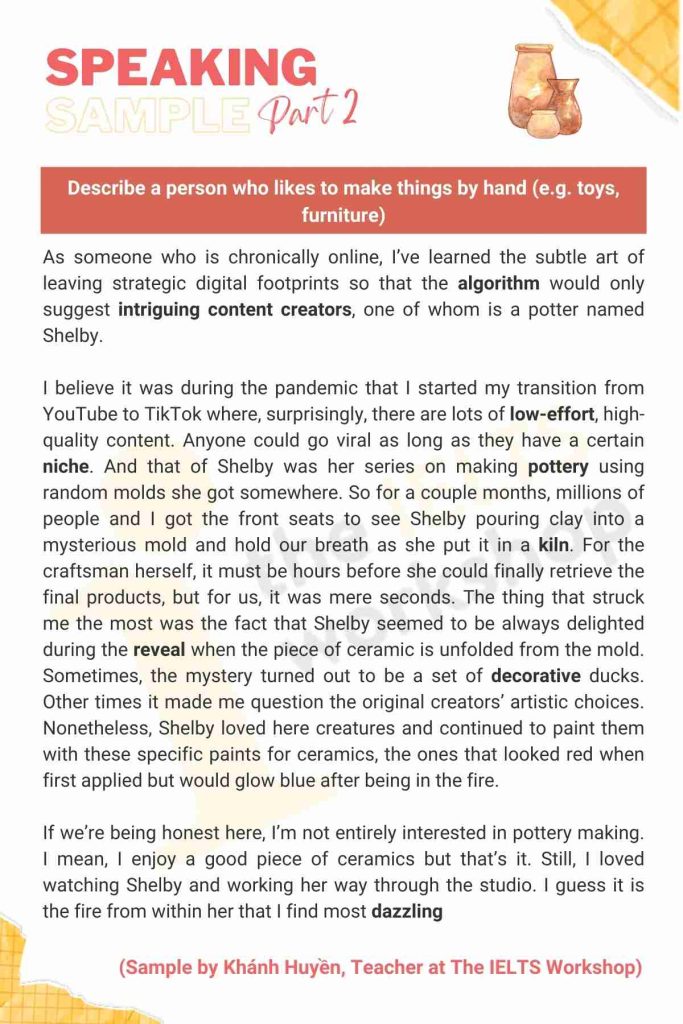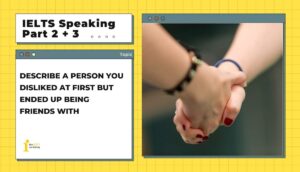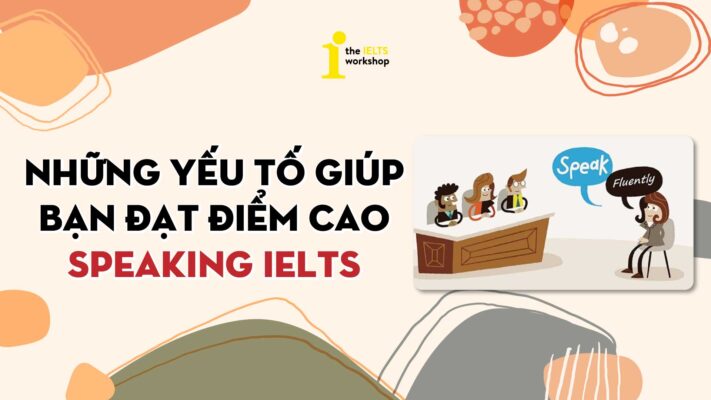Trong bài giải mẫu lần này, cô Khánh Huyền của The IELTS Workshop sẽ hướng dẫn bạn trả lời topic “Describe a person who likes to make things by hand (e.g. toys, furniture)“ trong IELTS Speaking Part 2. Cùng tham khảo sample, từ vựng và một vài cách diễn đạt ghi điểm trong phần thi IELTS Speaking nhé.
Part 2: Describe a person who likes to make things by hand (e.g. toys, furniture)
Describe a person who likes to make things by hand (e.g. toys, furniture)
You should say:
Who this person is
What he/she makes
Why he/she likes to make things by hand
And explain how you feel about the person.
Dưới đây là bài mẫu cho topic “Describe a person who likes to make things by hand (e.g. toys, furniture)“.
1. Bài mẫu (Sample)

2. Từ vựng (Vocabulary)
- algorithm: thuật toán
- intriguing: hấp dẫn
- content creator: người tạo nội dung
- low-effort: ít công sức
- niche: ngách thị trường
- pottery: đồ gốm
- kiln: lò nung
- reveal: tiết lộ
- decorative: trang trí
- dazzling: lấp lánh, rực rỡ
Part 3:
Bên cạnh Part 2, bạn hãy tham khảo thêm Part 3 cho chủ đề này nhé
How does modern technology change the handicraft industry?
Is it reasonable to charge a high price for handmade things?
Are there any traditional handicrafts in your hometown?
Why do many children like to make things by hand?
What are the benefits for students to learn to make things by hand?
1. How does modern technology change the handicraft industry?
Well, ever since the industrial revolution, mass production has been ever-increasingly prominent. As a result, productivity has been skyrocketing. But this also means a rampant homogenization of products and an eroding craftsmanship across many industry.
2. Is it reasonable to charge a high price for handmade things?
It is, in most cases. The way I see it, a steep price is justified by the plethora of investments that one must put into a creation. Say, the time spent on honing one’s skills, the money paid for materials, and of course, the demand of the market.
- plethora: nhiều
- hone one’s skills: luyện tập, trau dồi kĩ năng
3. Are there any traditional handicrafts in your hometown?
Technically, it is not traditional, but we do pride ourselves on our production of clothing, specifically anything wool. You see, some seventy years ago, one of the first factories in my country was established here so the whole town became industrial workers or started to learn how to knit and crochet.
- knit and crochet: đan & móc đồ len
4. Why do many children like to make things by hand?
Because it is fun, of course. But if you were to ask me on a deeper level, I would say it is the inexplicable joy of being able to create. For a moment, it was just some loose sheets of paper and sticks of glue, and the next it had turned into a paper lily or a jumping frog or a ninja star that you throw at your classmate.
- inexplicable: không nói nên lời
5. What are the benefits for students to learn to make things by hand?
By students, I assume it’s kindergarten and primary school students, so I would say it has some perks for their fine motor skills. Children at this age are still subconsciously developing hand-eye coordination and DIY projects are perfect to foster this. Another thing that comes to my mind is their much needed concentration. I mean, talk about an elixir to iPad kids!
- fine motor skills: kĩ năng vận động tinh
Bài mẫu bởi cô Khánh Huyền – Giáo viên The IELTS Workshop
Các bạn có thể tham khảo Bộ đề dự đoán IELTS Speaking của The IELTS Workshop để ôn tập những chủ đề mới cho kỳ thi IELTS sắp tới của mình nhé!
Nếu bạn muốn nhận Mentor 1-1 để hoàn thiện kĩ năng Speaking của mình trước khi bước vào kỳ thi, tham khảo ngay Khóa bổ trợ từng kỹ năng IELTS của The IELTS Workshop.









